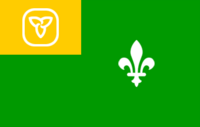Pays-d'en-haut

|

| |
| Subdivision of: | Ontario |
| Cities: | |
| Capital: | Outaouais |
| Largest: | ??? |
| Other: | Kingston |
| Languages: | |
| Official: | French |
| Others: | English, Algonquian, Scots |
| Lieutenant Moderator: | Étienne Poigret |
| Area: | c. 1,000,000 square miles |
| Population: | 5,319,026 persons |
| Established: | 1872 (official), Act of Parliament |
| Admission to Ontario: | 1803 (2nd) |
Pay-d'en-haut was once part of the French territory that included what is today New Francy. That changed in the wake of the French Revolution in 1789. Eventually, this strip of land joined Ontario. Its Gallophone origins are represented in the flag.
Government
As a result of the Re-Districting Act of 1872, Pay-d'en-haut shares with the other two Ontario Districts the same basic governmental structure:
- A District Council made up of elected representatives who serve for three-year terms. This acts as the district legislature.
- A Lieutenant Moderator elected by direct vote of the district's voters, who serves for one six-year term (technically, the election serves as a nomination process, which leads to the winner's appointment by Ontario's Moderator). This person acts as the district's chief executive.
Administrative Divisions
Pays-d'en-haut is divided into Counties, some of whom have Anglo origins. Unlike elsewhere in the province, these are always referred to as Counties as opposed to "Ridings."
Beausejour | Brant | Bourbon | Dauphin | Dundas | Durham | Elgin | Frontenac | Haldimand | Lorraine | Mattice-Val Côté | Niagara | Norfolk | Outaouais | Papineau | Prince Louis Island (Île-de-Prince Louis) | Stormont | Timiskaming
TO BE CONTINUED ONCE CERTAIN ASPECTS OF ONTARIO HISTORY HAVE BEEN RESOLVED